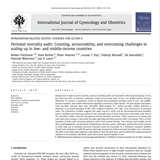
Background:
In high-income countries, national mortality audits are associated with improved quality of care, but there has been no previous systematic review of perinatal audit in low- and middle-income settings.
Objectives:
To present a systematic review of facility-based perinatal mortality audit in low- and middle- income countries, and review information regarding community audit.
Results:
Ten low-quality evaluations with mortality outcome data were identified. Meta-analysis of 7 before-and-after studies indicated a reduction in perinatal mortality of 30% (95% confidence interval, 21%–38%) after introduction of perinatal audit. The consistency of effect suggests that audit may be a useful tool for decreasing perinatal mortality rates in facilities and improving quality of care, although none of these evaluations were large scale. Few of the identified studies reported intrapartum-related perinatal outcomes. Novel experience of community audit and social autopsy is described, but data reporting mortality outcome effect are lacking. There are few examples of wide-scale, sustained perinatal audit in low-income settings. Two national cases studies (South Africa and Bangladesh) are presented. Programmatic decision points, challenges, and key factors for national or wide scale-up of sustained perinatal mortality audit are discussed. As a minimum standard, facilities should track intrapartum stillbirth and pre-discharge intrapartum-related neonatal mortality rates.
Conclusion:
The effect of perinatal audit depends on the ability to close the audit loop; without effectively implementing the solutions to the problems identified, audit alone cannot improve quality of care.